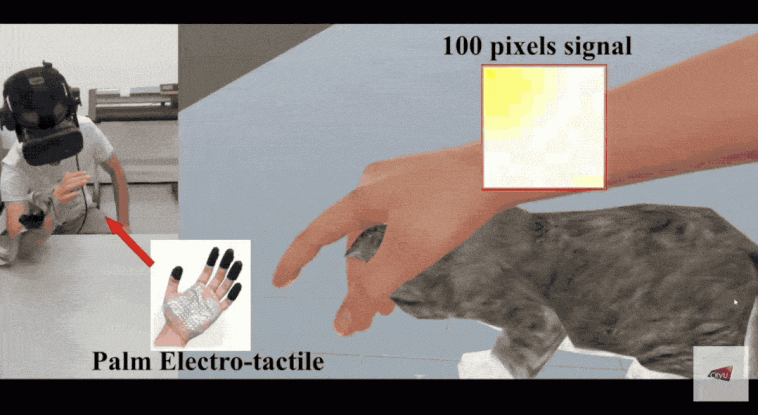Robotics X Labs and City University of Hong Kong have created a tactile “glove” with sensors between your palms and fingers that allow you to feel changes in roughness as you “stroking” cat fur at different speeds and directions.
Coupled with VR, you can achieve virtual cat licking.
When you put your hand in front of the cat’s tongue, you can still feel the barbs on it.
Wow, although the picture is still a little rough, after watching the cat cat teaching, I have been a little moved by this novel experience.
Having said that, how is this sense of touch achieved?
Haptic actuators thin enough to be integrated into finger cuffs
Existing tactile stimulation techniques can be divided into two categories – mechanical stimulation and electrical stimulation.
Mechanical stimulation is the application of a localized mechanical force or vibration on the skin through a mechanical actuator, thereby allowing people to feel the sense of touch.
However, such actuators are generally relatively large, and if they are to be integrated into portable or wearable devices, tactile resolution can only be sacrificed.
In contrast, electrotactile stimulators do not have this trouble and can be both lightweight and flexible, while providing higher resolution and faster response.
However, it requires a relatively high voltage to penetrate the outer layer of our skin to activate the nerves, so the safety cannot be guaranteed, and the tingling sensation caused by the electric shock also affects the experience.
In order to ensure the real feeling of cuddling cats, the research team chose to improve the electrical stimulation technology, and develop haptic actuators that can be integrated into finger cuffs.
There are two main technological innovations:
One is a high-frequency modulation method that can reduce the stimulation voltage to 13V to 28V.
Yes, unlike most electrohaptic actuators, which rely on high-voltage direct current (DC) pulses to penetrate the high-impedance stratum corneum (the outermost layer of the skin), the research team chose high-frequency alternating current (AC) here.
As shown in the figure below, since the electrical impedance of each layer of human skin can be modeled as a parallel resistance and capacitance, high-frequency alternating current can penetrate human skin and stimulate tactile nerves.
Through experiments, they found that increasing the frequency of alternating current stimulation (from 20kHz to 10kHz) resulted in higher current density and deeper penetration of the skin, which translated into more nerve activation, presenting a stronger sense of touch.
Simultaneously, stimulation with two AC currents with the same parameters but with a 180° phase difference further enhanced tactile perception.
In terms of specific performance, low-frequency and high-pressure stimuli can best simulate rough textures such as rock and sandpaper, while high-frequency and low-pressure stimuli can present smooth textures such as silk and glass.
Finally, the researchers obtained the lowest threshold voltage of 13V and the highest withstand voltage of 28V through volunteer tests, as well as a comfortable sensing range of 15V~25V.
In addition, 85% of subjects could perceive stimulus voltage changes in steps of as little as 0.5 V, which corresponded to at least 20 intensity intervals, much higher than the 4 in the earlier study.
The second innovation is the current steering ultra-high haptic resolution technology, which can quadruple the spatial resolution of the haptic actuator without additional hardware, reaching 76dots/cm2, which is close to human haptic perception.
And achieve a fast refresh rate that exceeds the human 4kHz, covering the entire human tactile intensity range.
Specifically, by using the high reconfigurability of the electrode array to perform stimulation at the position between the physical electrodes to achieve super-resolution, as shown in the figure below, the small triangle part is the target point.
Small bumps with a diameter of 1mm can also be felt through thick gloves
As shown, the researchers gave volunteers a “Braille test” where they could guess what letters/numbers were given by the strokes given by the haptic device.
Volunteers also donned firefighter gloves to test the sensitivity of the actuators.
As a result, it was able to successfully touch a small bump on the glass despite a thick layer.
——The diameter of this point is only 1mm, and the thickness is only 0.44mm.
Finally, in terms of applications, this technology can do a lot of things other than petting cats.
For example, virtual shopping, used to feel the material of different clothes.
Or help astronauts and deep-sea divers, etc. restore tactile perception under protective clothing.
In the more distant future, it could also come in handy in scenarios such as virtual training and even 5G remote surgery.




GIPHY App Key not set. Please check settings